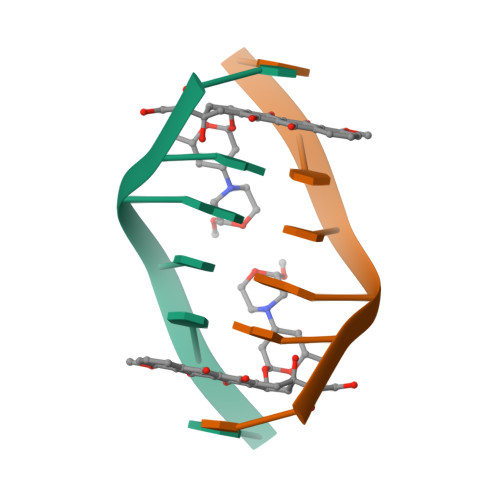 您的购物车当前为空
您的购物车当前为空
Doxorubicin hydrochloride
一键复制产品信息别名 盐酸多柔比星, NSC 123127, Hydroxydaunorubicin hydrochloride, DOX hydrochloride, Adriamycin HCl
Doxorubicin hydrochloride 是一种具有细胞毒性和抗肿瘤活性的蒽环类抗生素,是人类DNA拓扑异构酶I和II的有效抑制剂,IC50分别为0.8 μM和2.67 μM。它不仅能够降低AMPK及其下游靶蛋白乙酰辅酶A羧化酶的磷酸化,还可诱导细胞发生凋亡和自噬。在动物实验中,Doxorubicin hydrochloride 常被用于诱导急性肾衰竭、慢性肾损伤以及心力衰竭模型。

Doxorubicin hydrochloride
一键复制产品信息Doxorubicin hydrochloride 是一种具有细胞毒性和抗肿瘤活性的蒽环类抗生素,是人类DNA拓扑异构酶I和II的有效抑制剂,IC50分别为0.8 μM和2.67 μM。它不仅能够降低AMPK及其下游靶蛋白乙酰辅酶A羧化酶的磷酸化,还可诱导细胞发生凋亡和自噬。在动物实验中,Doxorubicin hydrochloride 常被用于诱导急性肾衰竭、慢性肾损伤以及心力衰竭模型。
| 规格 | 价格 | 库存 | 数量 |
|---|---|---|---|
| 5 mg | ¥ 155 | 现货 | |
| 10 mg | ¥ 273 | 现货 | |
| 25 mg | ¥ 455 | 现货 | |
| 50 mg | ¥ 745 | 现货 | |
| 100 mg | ¥ 1,320 | 现货 | |
| 200 mg | ¥ 2,150 | 现货 | |
| 500 mg | ¥ 3,180 | 现货 | |
| 1 g | ¥ 4,210 | 现货 | |
| 1 mL x 10 mM (in DMSO) | ¥ 328 | 现货 |
Doxorubicin hydrochloride 相关产品
产品介绍
| 产品描述 | Doxorubicin hydrochloride is an anthracycline antibiotic with cytotoxic and antitumor activity. It is an effective inhibitor of human DNA topoisomerase I and II, with IC50 values of 0.8 μM and 2.67 μM, respectively. In addition to inhibiting DNA topoisomerases, it can reduce the phosphorylation of AMPK and its downstream target, acetyl-CoA carboxylase. Doxorubicin hydrochloride also induces apoptosis and autophagy. In animal studies, it is commonly used to induce models of acute renal failure, chronic kidney injury, and heart failure. |
| 靶点活性 | Topo I:0.8 μM, Topo II:2.67 μM |
| 体外活性 | 方法:人乳腺癌细胞 MCF10A、BT474、MCF-7 和 T47D 用 Doxorubicin hydrochloride (0.1-10 μM) 处理 48 h,使用 MTT 方法检测细胞生长抑制情况。 |
| 体内活性 | 方法:为检测体内抗肿瘤活性,将 Doxorubicin hydrochloride (1 mg/kg/4 天) 和 lovastatin (5 mg/kg/天) 腹腔注射给携带鼠黑色素瘤肿瘤 B16F10 的 B6D2F1 小鼠,持续两周。 |
| 细胞实验 | To analyze the effect of Bcl-2 expression on the viability of HUVECs treated with Dox, cells were co-transfected with 200 ng of the pEGFP-spectrin expression plasmid together with 200 ng of either pCDNA3-hBcl-2 or the control pCMVβ-galactosidase expression vector (33). The pGL3 Basic vector (2.1 μg) was added as a DNA carrier in a total volume of 0.140 ml, and transfection was performed by the calcium phosphate procedure in 35-mm tissue culture dishes. After treatment, the cells were washed with PBS, fixed with 3.7% formaldehyde for 15 min, and washed for a further 10 min with 50 mM NH4Cl blocking solution in PBS. Cells were then washed with PBS, permeabilized with a 0.1% Triton X-100 for 10 min, washed again with PBS, and stained with 1 μg/ml 4′,6-diamidino-2-phenyl-indole solution for 2 min. The cells were examined under a fluorescence microscope, and GFP-positive cells were scored after counting a minimum of 1000 total cells for each condition. The efficiency of transfection in Bcl-2- and β-galactosidase-expressing cells, determined in aliquots of transfected cells just before the addition of Dox, was similar (10–12%) [1]. |
| 动物实验 | Athymic male nude mice (3-4 weeks old) are used. PC3 cells (4×106) are injected subcutaneously into the flanks of mice. Animals bearing tumors are randomly assigned to treatment groups (five or six mice per group) and treatment initiated when xenografts reached volumes of about 100 mm3. Tumors are measured using digital calipers and volume calculated using the formula: Volume=Width2×Length×0.52, where width represents the shorter dimension of the tumor. Treatments are administered as indicated using vehicle (PBS containing 0.1% BSA), Doxorubicin (2-8 mg/kg), Apo2L/TRAIL (500 μg/animal), or a combination of 4 mg/kg Doxorubicin followed by 500 μg Apo2L/TRAIL. Doxorubicin is administered systemically whereas Apo2L/TRAIL is given either intratumorally or systemically. All treatments are given once. Mice are monitored daily for signs of adverse effects (listlessness and scruffy appearance). Treatments seemed to be well tolerated. The mean±SEM is calculated for each data point. Differences between treatment groups are analyzed by the student t-test. Differences are considered significant when P<0.05 [3]. Altogether, 29 male Wistar rats (weight 306 ± 18.6 g) were used in the study. Animals were divided into three groups: control (group C; n = 10; 306.4 ± 17.2 g), animals treated with DOX (group DOX; n = 10; 305.0 ± 24.9 g) and animals treated with L-DOX (group L-DOX; n = 9; 306.7 ± 15.0 g). Vehiculum (aqua pro injection), DOX and L-DOX were applied to group C, DOX and L-DOX, respectively, by single intraperitoneal injection; concentration of both DOX and L-DOX was 5 mg/kg, similar to the concentrations used in human treatment protocols. All animals were sacrificed 24 h after drug application. Thoracotomy was performed, hearts were excised and samples were obtained separately from the free wall of the left atrium (LA), left ventricle (LV), right atrium (RA) and right ventricle (RV).Samples were placed into RNA later preservation solution and stored at -80 C until further analysis [4]. |
| 别名 | 盐酸多柔比星, NSC 123127, Hydroxydaunorubicin hydrochloride, DOX hydrochloride, Adriamycin HCl |
| 分子量 | 579.99 |
| 分子式 | C27H29NO11·HCl |
| CAS No. | 25316-40-9 |
| Smiles | Cl.COc1cccc2C(=O)c3c(O)c4C[C@](O)(C[C@H](O[C@H]5C[C@H](N)[C@H](O)[C@H](C)O5)c4c(O)c3C(=O)c12)C(=O)CO |
| 密度 | no data available |
| 存储 | Powder: -20°C for 3 years | In solvent: -80°C for 1 year | Shipping with blue ice/Shipping at ambient temperature. | ||||||||||||||||||||||||||||||||||||||||
| 溶解度信息 | DMSO: 240 mg/mL (413.8 mM), Sonication is recommended. H2O: 50 mg/mL (86.2 mM), Sonication is recommended. | ||||||||||||||||||||||||||||||||||||||||
| 体内实验配方 | 10% DMSO+40% PEG300+5% Tween 80+45% Saline: 5 mg/mL (8.62 mM), Sonication is recommended. 请按顺序添加溶剂,在添加下一种溶剂之前,尽可能使溶液澄清。如有必要,可通过加热、超声、涡旋处理进行溶解。工作液建议现配现用。以上配方仅供参考,体内配方并不是绝对的,请根据不同情况进行调整。 | ||||||||||||||||||||||||||||||||||||||||
溶液配制表 | |||||||||||||||||||||||||||||||||||||||||
H2O/DMSO
DMSO
| |||||||||||||||||||||||||||||||||||||||||
化合物与蛋白结合的复合物

CRYSTAL STRUCTURE OF FOUR MORPHOLINO-DOXORUBICIN ANTICANCER DRUGS COMPLEXED WITH D(CGTACG) AND D(CGATCG): IMPLICATIONS IN DRUG-DNA CROSSLINK




 很棒
很棒

 |
|
评论内容